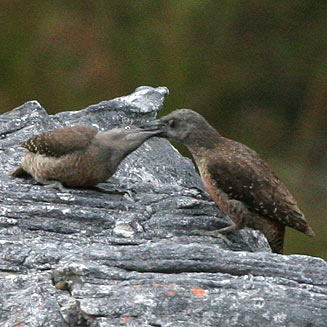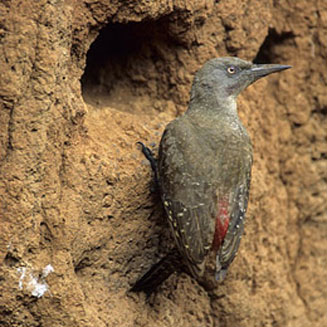|
Geocolaptes olivaceus (Ground
woodpecker)
Grondspeg [Afrikaans]; Ungximde [Xhosa]; umNqangqandolo
[Zulu]; Khatajoe, Mohetle [South Sotho]; Xidzingirhi (also used as generic term
for firefinches and waxbills) [Tsonga]; Kaapse grondspecht [Dutch]; Pic
laboureur [French]; Erdspecht [German]; Pica-pau-das-rochas [Portuguese]
Life
> Eukaryotes >
Opisthokonta
> Metazoa (animals) >
Bilateria >
Deuterostomia > Chordata >
Craniata > Vertebrata (vertebrates) > Gnathostomata (jawed
vertebrates) > Teleostomi (teleost fish) > Osteichthyes (bony fish) > Class:
Sarcopterygii (lobe-finned
fish) > Stegocephalia (terrestrial
vertebrates) > Tetrapoda
(four-legged vertebrates) > Reptiliomorpha > Amniota >
Reptilia (reptiles) >
Romeriida > Diapsida > Archosauromorpha > Archosauria >
Dinosauria
(dinosaurs) > Saurischia > Theropoda (bipedal predatory dinosaurs) >
Coelurosauria > Maniraptora > Aves
(birds) >
Order: Piciformes
> Family: Picidae
 |
 |
| Ground woodpecker. [photo Peter Steyn ©] |
Ground woodpecker on termite mound,
Boland trail, Western Cape, South Africa. [photo H. Robertson,
Iziko ©] |
The Ground woodpecker is endemic to South Africa, Swaziland
and Lesotho, being found in hilly, mountainous areas. It has a highly specialized
diet, with about 99.8% of its diet ants, digging up subsurface ant nests,
licking them up with its sticky tongue. Its nest is excavated by both sexes, and
consists of a tunnel
and egg chamber, normally dug into earthen banks. It lays 2-4 eggs, which are
incubated by both sexes. The chicks are cared for by both parents, begging
loudly for them to regurgitate food (see image). The fledglings stay
dependent on their parents until the onset of the next breeding season.
Distribution and habitat
Endemic to South Africa, Swaziland
and Lesotho, occurring in hilly, mountainous areas of the Western, Eastern and
Northern Cape, Lesotho and the Free State Province. It occurs in rock and boulder
strewn slopes of mountains, usually in treeless grasslands and shrublands.
|
 |
|
Distribution of Ground woodpecker in southern
Africa, based on statistical smoothing of the records from first SA Bird
Atlas Project (©
Animal Demography unit, University of
Cape Town; smoothing by Birgit Erni and Francesca Little). Colours range
from dark blue (most common) through to yellow (least common).
See here for the latest distribution
from the SABAP2. |
Food
It is highly specialized, as ants form approximately 99% of
its diet, digging up subsurface ant nests and licking them up with its sticky
tongue. It eats so many ants that it can decrease the ant population in its area
by as much as 25-50%! The following food items have been recorded in its diet:
- Insects
- Formicidae (ants), as well as their eggs, larvae and pupae:
- Camponotus
- Anoplolepis
- Acantholepis
- Crematogaster
- Tetramorium
- Pheidole
- Meranoplus
- Solenopsis
- Coleoptera
(beetles)
-
termites
Breeding
- Both sexes excavate the nest, which consists of a 0.5-1.0m long tunnel
ending in a circa 15 cm wide egg chamber. It is usually dug into earthen
banks, such as riverbanks and gullies, or in crumbling walls of abandoned
buildings or termite mounds.
- Egg-laying season is from July-December, peaking from August-September.
- It lays 2-4 eggs, which are incubated by both sexes.
- The chicks are cared for by both parents, begging loudly for the parents
to regurgitate food (see image below). The fledglings remain dependent on their
parents until the onset of the next breeding season.
 |
 |
|
Ground woodpecker regurgitating food to juvenile,
Boland trail, Western Cape, South Africa. [photo H. Robertson, Iziko ©] |
Ground woodpecker at its nest, Wakkerstroom, South
Africa. [photo Warwick Tarboton ©] |
Threats
Not threatened, in fact widespread and common in protected
areas.
References
-
Hockey PAR, Dean WRJ and Ryan PG (eds) 2005. Roberts
- Birds of southern Africa, VIIth ed. The Trustees of the John Voelcker
Bird Book Fund, Cape Town.
|
